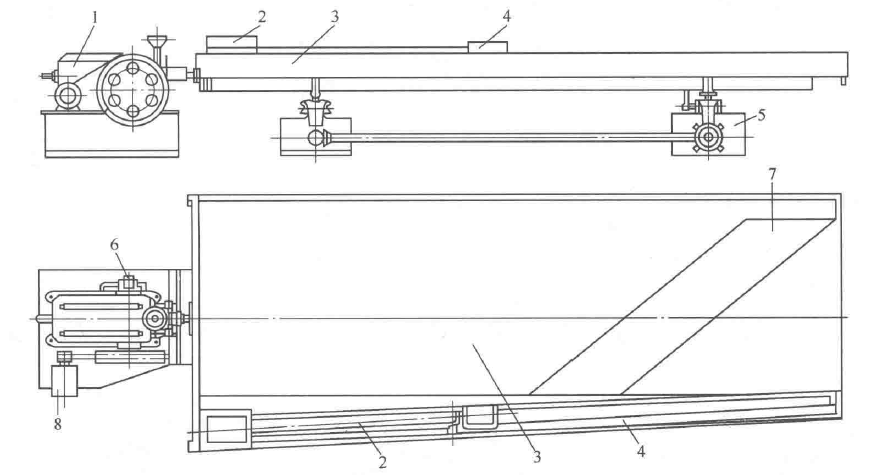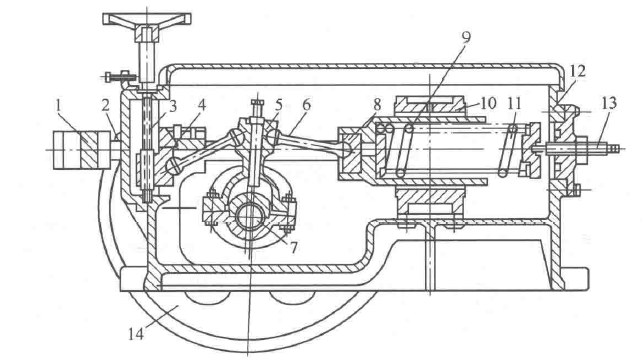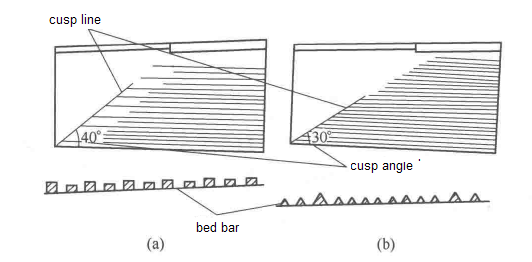In the gravity separation process, the shaking table is the most common equipment. In many kinds of shaking table, the 6S type is the most common application.
The structure of the 6S shaking table produced by Sinonine is shown in Figure 1. Its mechanism is the eccentric connecting rod shown in Figure 2. The motor uses the pulley to drive the eccentric shaft to drive the eccentric shaft to move up and down the rocking rod on the eccentric shaft, and the elbow plate on both sides of the rocking rod is swinging up and down, the bearing seat of the front elbow plate is fixed, and the bearing seat of the elbow plate is supported on the spring. When the elbow plate falls, the back plate seat is moved backward by the compression spring, thereby passing through, thereby passing through the elbow plate seat. The reciprocating rod drives the bed surface to retreat; when the elbow plate swings upward, the spring extends, keeping the elbow plate and the elbow plate seat not detached, and pushing the bed surface forward.

Fig1.6S shaking table structure
1. mechanism, 2. feeder, 3. bed, 4. water tank, 5. slope adjustment mechanism, 6. lubrication system, 7. bed strip, 8. motor.

Fig2. mechanism structure
1. linkage seat; 2. reciprocating rod; 3. adjusting wire rod; 4. adjusting slider; 5. rocking rod; 6. elbow plate; 7. eccentric shaft; 8. elbows seat 9. spring; 10. bearing seat; 11. rear axle; 12. box; 13. adjusting bolt; 14. big wheel
When the bed deck moves forward, the angle between the two elbow plates decreases from big to small, so the velocity of the bed moves slowly. On the contrary, when the bed is retreating, the velocity of the bed is fast and slow, thus forming a rapid return motion. The fixed elbow plate seat is also called a slider. The sliding block can move up and down in the range of 84mm through the handwheel, so as to adjust the stroke of the cradle. It is necessary to replace the pulley with different diameters when adjusting the bed surface.
The bed deck of 6-S shaking table is supported by 4 plate rocker, which has small shaking resistance and slightly fluctuating vibration on the surface of the bed, which is more favorable to the loosening of the material on the surface of the bed. But it will also cause fluctuation of water flow, so it is not suitable for dealing with fine particles. The surface of the 6S rocking bed is a right angle trapezium, from the drive end to the concentrate end has an ascending slope of 1 degrees to 2 degrees.
Bed deck shape
The bed deck of the shaking bed has two kinds: left and right (see Fig. 3). Standing on the transmission side, the right side of the ore side is called the right cradle, and the left side is called the left shaking table. In the gravity beneficiation plant, the installation of the shaking table can be arranged symmetrically, so that the plant is compact in configuration and saves the floor area of the shaking table.

Fig3. Two kinds of shaking table deck
There are rectangular, trapezoidal, and rhomboidal surfaces commonly used in the shaking table. The most commonly used is the trapezoidal bed. The bed deck of the shaking table is made of wood. In order to prevent the water from being eroded, it is often used to make a wear-resistant layer on the bed surface with lacquer, glass steel or polyurethane.
Shaking table bar
The section shape of the common bed bar is shown in Figure4

Fig4. cusp angle of the shaking table
a.Groove bar, b. rectangular bed strip, c. triangular bed bar
The bed bar of rectangular section is suitable for coarse sand shaking table. The triangular section bed bar is suitable for fine sand and mud shaking table, and the section of groove bar is triangular. It is suitable for slime shaking table.
All the bed bars are gradually reduced from the drive end to the end of the concentrate. At the end of the concentrate, all the bed strips on the bed and the tailings side of the bed are pointed out to a certain angle, and the angle between the tip and the tailings side of the bed is called the cusp angle of the shaking table, as shown in Figure 5. The sharp angle of the coarse sand shaking table is generally 40 degrees, and the tip angle of the slime shaking table is generally 30 degrees.

Fig5. cusp angle of the shaking table
a. Coarse sand shaking table b. slime shaking table
On the transverse side of the shaking table, the height of the bed bar gradually increases along the side tailings side to avoid the loss of high-density mineral particles into the tailings. The 44~50 bed bars are generally installed on the bed deck of the sand bed on the flat bed surface.
Please look at the working video of the 6S shaking table: